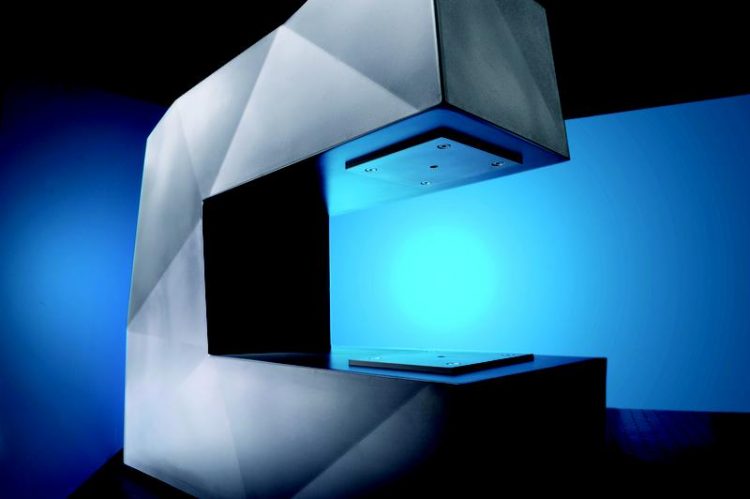Measuring paper thickness fast and reliably

Picture 1: The “bd-2” thickness measurement system based on bidirectional sensors. © Fraunhofer ILT, Aachen, Germany.
Materials and quality control must meet increasingly stringent requirements in the paper processing industry. To provide thickness measurement, for instance, sensors must now be accurate down to the sub-micron range yet nonetheless operate in the production line as fast as possible and with minimal maintenance.
To meet these requirements the optical thickness measurement system “bd-2” (for bidirectional measurements) was developed at Fraunhofer ILT. The sensor sends a measuring beam onto the material surface and the reflected signal allows the distance to be measured with a precision of 200 nm. The sensor has been previously used, e.g. for surveying cold-rolled metal sheets.
A special feature of the system is the 70 kHz sampling rate. This allows for an absolute and continuous measurement of the distance to the surface during running production. The thickness measurement system “bd-2” comprises two sensing heads mounted in a C-frame to measure the thickness of the product passing by.
“bd-2” is suited to measure the thickness of paper and board webs in the range of 10 µm to several millimeters. Untreated surfaces are measured as safe as painted, embossed, smoothed or supercalendered.
A new sensing head simplifies the entire measurement process
Compared with established methods – such as radiometric, capacitive or inductive methods – the new sensor offers several advantages:
Since irradiated and reflected beams are propagating along the same line, alignment efforts are eliminated as transmitter and receiver no longer have to be adjusted to each other.
To send and to receive the backscattered radiation only a small measuring head with a weight of 100 g is needed. It uses a small window with a 2 mm diameter, the cast protected by an air stream in harshest environments reliably against contamination. Compared with conventional sensors its spot diameter is about 100 microns, so that even the smallest structures can be detected.
Control processes safely
The new sensor »bd-2″ provides the accuracy of interferometric measurement methods and is significantly faster than the established measurement technologies. The complete system processes up to 70,000 thickness readings per second. So, inline measurements are possible even at high product speeds that enable fast feedback loops to control and optimize production processes.
Sensor sets new standards for industrial manufacturing
In terms of speed and integrability, “bd-2” sets new standards for process control and quality assurance in various industry segments. The process paves the way for the transition from laboratory-based individual measurement to continuous inline production control. This is why the Fraunhofer ILT experts are targeting industry customers looking to meet higher accuracy requirements in series production, offering them not just complete systems but also extensive consulting in relation to process integration. The sensors were tested extensively in pilot plant operation, first industry partners have already carried out test runs with the system in their production lines.
Fraunhofer ILT at CONTROL 2016
The interferometric thickness sensor »bd-2« will be showcased at this year’s CONTROL in Stuttgart, Germany on the stand 1502of the Fraunhofer Alliance Vision in Hall 1.
Contact
Dr. Stefan Hölters MBA
Interferometrical Sensors
Telephone +49 241 8906-436
stefan.hoelters@ilt.fraunhofer.de
PD Dr. Reinhard Noll
Head of the Measurement
Technology and EUV Sources
Competence Area
Telephone +49 241 8906-138
reinhard.noll@ilt.fraunhofer.de
Media Contact
All latest news from the category: Machine Engineering
Machine engineering is one of Germany’s key industries. The importance of this segment has led to the creation of new university degree programs in fields such as production and logistics, process engineering, vehicle/automotive engineering, production engineering and aerospace engineering among others.
innovations-report offers informative reports and articles covering technologies such as automation, motion, power train, energy, conveyor, plastics, lightweight construction, logistics/warehousing, measurement systems, machine tools and control engineering.
Newest articles

Zap Energy achieves 37-million-degree temperatures in a compact device
New publication reports record electron temperatures for a small-scale, sheared-flow-stabilized Z-pinch fusion device. In the nine decades since humans first produced fusion reactions, only a few fusion technologies have demonstrated…

Innovative microscopy demystifies metabolism of Alzheimer’s
Researchers at UC San Diego have deployed state-of-the art imaging techniques to discover the metabolism driving Alzheimer’s disease; results suggest new treatment strategies. Alzheimer’s disease causes significant problems with memory,…

A cause of immunodeficiency identified
After stroke and heart attack: Every year, between 250,000 and 300,000 people in Germany suffer from a stroke or heart attack. These patients suffer immune disturbances and are very frequently…





















